“Harriers” in battle: Falklands conflict 1982 (part of 6)
What the British air defense is worth in practice, with all the mercilessness, showed only one Aermacchi MV-339А - a training jet airplane with a maximum speed of 817 km / h, which did not have its own radar. When Lieutenant Esteban nevertheless managed to inform the command of the beginning of a full-scale British invasion, the command of the Malvinas Islands task force sent a couple of such airplanes to reconnoiter, but one of them was unable to take off for technical reasons. The second pilot, Lieutenant Commander G. Influenza, using the fog, the terrain folds, came out to the amphibious group from the north and ... of course, the appearance of the plane, flying at 800 km per hour flying 200 meters above the waves, was a complete surprise to the English. But he didn’t lose a bit and, having assessed the scale of the invasion, he decided to slightly “fool around” by attacking the frigate Argonot with his NURS and the 30-mm cannon fire. He even got in, easily wounding three sailors and slightly damaging the frigate hull, but then the British still woke up. A missile from Blupipe MANPADS was launched from the Canberra, the Intrepid docking ship attacked the impudent C-Cat missile system, but G. Influenza, performing an anti-missile maneuver, delicately shaken both missiles from the tail, and the nasal fire Plymouth’s artillery system also failed to achieve the goal. The lieutenant captain returned to Stanley and reported the invasion.
Why the plane was not intercepted by Sea Harriers? According to some information, the British at that moment were just changing shifts, and at the time of the flight of the daring Airmachi of the British air patrol there was simply no connection.
The Argentine Falkland Islands Command informed the mainland of the invasion, but without waiting aviation from continental bases, combat-ready aircraft were lifted from the airport of Goose Green (base "Condor") - there were as many as 4 "Pukars". This "thunderstorm" attempted to attack British ships, but one plane was shot down by the Blownpipe MANPADS of some lucky marine, and the second was destroyed by the Sea Harrier, which was aimed at the target by the destroyer Entrim. The other two still got to the ships, but, met by dense anti-aircraft fire, were forced to retreat. I will not ask why the Harriers did not kill the Argentines on the way, but why did the British air patrol leave them? However, then the real combat aircraft of Argentina entered into business.
In 10.31, a trio of “Daggers” at speed 980 km / h attacked “Broadsworth”, “Argonot” and “Plymouth”. Argentines fired at the CC C missiles at Argonot, Plymouth and Intrepid, but to no avail, but Broad Wolf, C Wolfe, was successful - one Dugger was shot down. Argentine bombs did not hit anywhere, but gunfire wounded 14 people on Broadsward and destroyed two helicopters on board. At the same time, the second three of the Daggers attacked the Entrym - and achieved two hits of aerial bombs. Both did not explode, but the Entrym caught fire, and some of its equipment left standing, with one of the bombs stuck inside the hull. After the attack, the Argentines attempted to intercept "Sea Harriers", but to no avail - the Daggers easily broke away from them.
Entrym tried to retreat under the protection of other ships, but did not have time - the next attack began. Two Daggers attacked the ship, firing at it with cannons, injured a 7 man, the ship caught fire even more, and the fire threatened the cellars of the SI Slug air defense system, so the missiles had to be dropped overboard. Another trio of “Daggers” attacked the “Brilliant”, the bombs went wrong, but the Argentines did not suffer any losses - all three cars returned to the base. The second attack covered the 4 fighter "Mirage", but could not detect the "Sea Harriers" and returned home without a fight.
In total, the first wave involved 15 aircraft, 11 "Daggers" and 4 "Mirage", they attacked the British four times, damaged the ship's 2, lost one aircraft and were never intercepted by the British air patrol.
An hour passed, and the fighting resumed: two Pukary from the Condor base attempted to attack the frigate Ardent, but were driven away by fire from the CC Sea missile system and artillery. However, the persistent Argentines did not lose hope, and through 20 they crumpled to attack again, but this time they were intercepted by Sea Harriers — one Pucara was shot down, the second left. But the second wave of airplanes from the continent was approaching - Skyhocks 10. Alas, only 8 of them flew to the Falklands, two of them were forced to return due to technical faults, so two F4s went to the Falklands. One of them was intercepted by Sea Harriers, Skyhawks dropped bombs and tried to break away, but only two aircraft managed to do this, the other two were shot down by Sidewinders. The second four were not too lucky either - one plane had to return home directly from West Falkland due to technical problems, the remaining three discovered the ship, but the commander, suspecting something was wrong, ordered not to attack him. Alas, one of the Skyhawks managed to drop bombs, and in vain - it would have been abandoned by the Argentines of the Rio Karakan. The remaining two aircraft attacked the "Ardent", did not get into it, but did not get into them, so that the cars left undisturbed. Another four Skyhocks, which set off a little later and reduced in flight to three, because for technical reasons, one plane returned half-way, somehow did not find the enemy, and returned to the airfield.
And then the third wave hit the British.
Two Skyhawk links “lost” the plane on the road (again, technical reasons), but the remaining five put two bombs in the Argonot, and 8 exploded near the ship. Both bombs that hit the ship did not explode, but the fire and the detonation of the rocket cellar were crying out, so the frigate was in a very difficult position. The four Daggers (five flew out, but the fifth was forced to return) went out to the British ships from the south, but were found by the Diamond frigate, which guided the Sea Harrier duty crew on them. This time, the British pilots managed to intercept the Argentines and even knock down one Dagger, but the rest entered the “no-fly zone” where they attacked the frigate “Ardent”, managing to achieve three hits, and then returned to the airfield.
At this time, two flight managers of three Daggers each attempted to attack the British ships at San Carlos - but the Diamond frigate once again distinguished itself: having noticed the enemy aircraft in time, he gave target designation to the second pair of Sea Harriers, and piling on one of the links completely destroyed it - all three aircraft, survived only one pilot. However, the second trio broke through - in order to get under concentrated anti-aircraft fire: the Entrim, Plymouth and Intrepid attacked the Sea Cat missiles, the Sea Wolfe worked with the Diamond, but not a single rocket reached the target. The Daggers attacked the Brilliant, but were only able to scratch it slightly with cannon fire.
The last chord was the attack of three Skyhocks, which finished off Ardent - 7 bombs hit the ship, 22 people died, 37 was injured. The frigate received deadly damage, the crew soon left it (the Yarmouth took off the people) and soon a strong explosion split the Ardent in half. But the Argentines were not allowed to leave - the C Sea Harrier couple, which appeared too late to save the frigate, shot down two Skyhawks, and the third one badly damaged, so the pilot barely reached Port Stanley, where he ejected.
There was a fourth wave, but the Skyhocks 9 sent to the battle could not find the enemy - low clouds and twilight reduced visibility to a minimum.
A total of 21 in May, Argentinean air detachments and individual planes attacked the British 15 once, the British VTOL failed to intercept the enemy planes before the 5 attack, but only in two of the five cases did the Argentine aerial attacks fail. In other cases, the Argentines, suffering losses, still broke through to the ships. Twice "Sea Harriers" tried to pursue the Argentines after the attack, once - successfully. The British lost the frigate Ardent, and the Entrym and Argonot were badly damaged, another 2 frigate was slightly scratched. Argentines have lost their 5 Daggers, 5 Skyhocks and 3 Pucaras - with the exception of one Dagger and one Pucara, this is the merit of Sea Harriers.
So what did happen on May 21? A categorical discrepancy between the number of Argentine aviation and the number of combat sorties made by it draws attention. The Argentinean commanders were preparing for the landing of the British and according to the plan (and simply according to common sense) at the time of the landing they were supposed to beat all that is at hand. However, having approximately 75-78 relatively modern aircraft were able to make only 58 departures (the remaining 7 departures on the account of "Pukar" and "Airmachi").
The results of the May 21 battles provide an excellent basis for analyzing the effectiveness of VTOL aircraft against horizontal takeoff and landing aviation. In total, as mentioned above, the Argentine aviation made 65 sorties. As practice shows (the actions of the MNF air force during the “Storm in the Desert”, the operation of the VKS in Syria) airplanes of first-class powers are able to make at least 2 combat sorties a day, the British at Falklands sometimes flew more often. Thus, 65-smoleto departures on British ships could provide air group number 32-33 machine, and if you divide by aircraft types according to their sorties - 1 «Eyrmachi», 3 «Pucara», 2 «Mirage», 11 «daggerov And 16 Skyhocks. In other words, the Air Force of Argentina and the Navy were able to provide such an impact on the British, which the US Air Force or the modern Russian Federation would need to have an 33 aircraft. Considering the fact that the British themselves had 25 "Sea Harriers" (the five attack aircraft do not count, since they could not perform the functions of air defense), we can talk about parity. And what is the result?
From the point of view of downed airplanes, definitely in favor of Sea Harriers, since they destroyed 11 airplanes: 2 Pukary, 4 Dagger and 5 Skyhawks, which would be 30% of the air group we calculated. But from the point of view of accomplishing its immediate task - the air defense of the compound - except as a deafening failure of the action of the British VTOL aircraft and not to name it. Of the 15 groups of aircraft that attacked the British, only 5 groups or 33% were intercepted, while the British managed to thwart only 2 attacks - 13,4%! Thirteen breakthroughs to British ships from 15 attempts ... And this is under the conditions when Argentines attacked, not having "flying control points" - DRLO planes, without covering their links with EW planes, not suppressing British fighter points with anti-radar missiles, without providing air cover shock links (4 Airplane "Mirage" disappeared in vain). Bottom line: one sunk ship and two badly damaged ones - when the Argentines did not use a guided weapons, but only free-fall bombs and NURS, and the bombs regularly did not want to explode! The tactics of the Argentine planes that operated in 1982 did not differ much from the tactics of the Second World War, and if they were different, it was only for the worse - the Argentines lacked torpedo bombers who could have done things in the Falkland Strait and the Argentines were never able to some massive attacks, nothing like the famous "star" raids, when the same Japanese surrounded the enemy ships and then attacked them from several angles, the Argentines did not show.
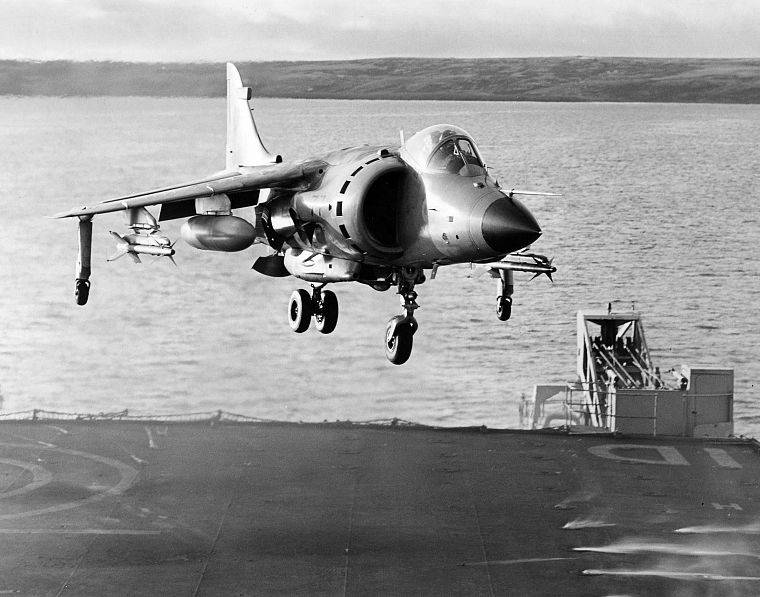
On the other hand, it must be remembered that not all of the British Sea Harriers available to them were used to cover the amphibious unit — a significant part (but unknown to the author) was behind the brackets and guarded the aircraft carriers. And now we can much better understand the reasons of Rear Admiral Woodworth, who did not want to place his aircraft carriers between the continental air bases of Argentina and the Falkland Islands. Assuming that he engaged half of his VTOLPs to protect aircraft carriers, even if the effectiveness of his carrier-based aviation while guarding the main forces of the 317 th operational link advanced would be 2-3 times higher than that demonstrated above the amphibious-class ships, but concentrate Argentines hitting their aircraft carriers - the British do not hold back. It is very likely that the British commander would have remained at least without one aircraft carrier (maybe not sunk, but incapacitated). And if Woodward was opposed by properly organized air forces of 30-40 aircraft (with reconnaissance, EW, etc.), trained to fight over the sea and provided with guided weapons (the same anti-rocket Exocoet) in sufficient numbers, with probability 99 % its operational connection would be destroyed.
Interestingly, in all five cases, when the British VTOL 21 in May intercepted enemy planes, the British pilots did this by hovering from their own warships. For the first time (on the four of the Pukar), Sea Harriers was brought in by the Antrim - it was there that the control point for the amphibious group air cover was located. Alas, being the center of British air defense, the ship failed to protect itself, and after being hit by two bombs, it transferred the control functions of the air patrol to the Diamond frigate. It was he who carried out the guidance in the remaining four cases: interception of four Skyhawks (two were shot down), four Daggers (one shot down) and three Daggers (all three were shot down), as well as two crazy Pukar attack aircraft, attacking the frigate Antrim. In addition, "Brilliant" was able to bring "Sea Harriers" and "Skyhawks", who finished off "Ardent."
Naturally, the ships as control points of aviation were not very good at all - even if only because of the low detection range of enemy aircraft. Of course, the position of the British ships also played its role - being in a “box” surrounded by mountainous shores, they could not detect the Argentines beforehand, as a result of which the “Sea Harriers” had very little time to intercept. However, in the open sea, the situation did not improve much - in any case, a plane going at low altitudes was detected by shipborne radar too late.
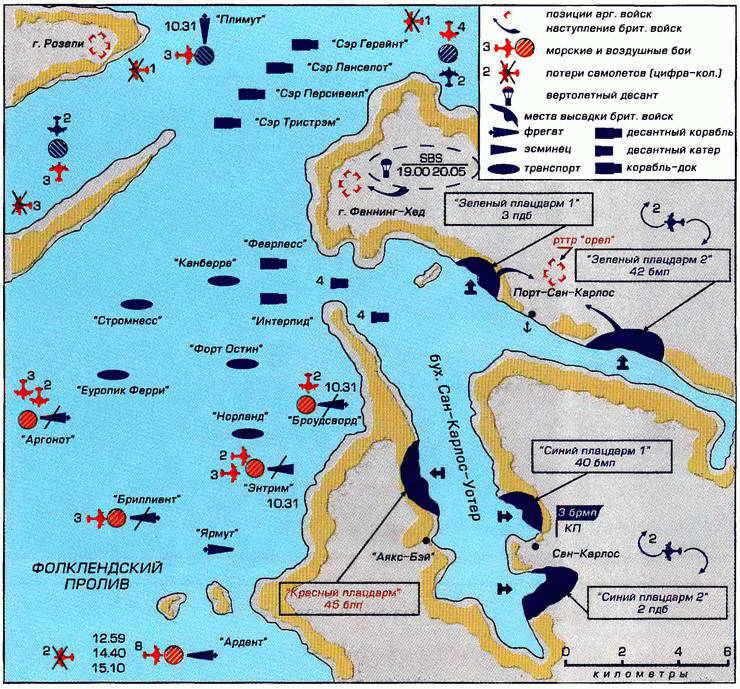
Thus, if the Argentinean pilots continued to rush to the ships after the discovery of the Sea Harriers, before the entry of their aircraft into the air defense zone of the formation, the British pilots simply did not have time to destroy the enemy. So, for example, 4 "Dagger", went on the attack, despite the fact that the air patrol managed to shoot down only one aircraft, after which he was forced to stop the pursuit, in order not to expose the attack of relatives of the air defense missile system. But in another case, when the British had more time, and the Argentines started a series of maneuvers, trying to shake off the British from the tail, not one of the three Daggers survived. If the British had air defense control posts (in the form of the same DRLO aircraft), the effectiveness of Sea Harriers would be much higher, simply due to the fact that targeting them would arrive earlier and the time for interception and air combat would be longer. However, it is necessary to recognize that if fighter planes of horizontal takeoff and landing were in place of the VTOL aircraft, their effectiveness would be even higher. Nevertheless, "Sea Harriers" lacked neither ammunition (only two "Sidewinders"), nor speed. Three Daggers, attacked by the British after they had stormed the ships, simply left the area at high speed and the VTOL aircraft could not do anything about it. In another case, intercepting the four Skyhocks, the British were able to shoot down only two of them - the rest fled. If the British had the same "Phantoms" - the above-mentioned "Daggers" and "Skyhawks" would not have left them.
The main reason for the low effectiveness of Sea Harriers as a means of air defense of the compound is the lack of timely external targeting. If the British had several “E-2C Hokai” that could control the airspace effectively and at a great distance for several hours, as well as control air patrol fighters, the number of successful interceptions would be much more - but for this the British would have to have a full-fledged ejection aircraft carrier, which they did not have.
Let's go back to the Falklands. The first day of fighting left the parties in unstable equilibrium - the Argentines suffered significant losses in the aircraft, but the British had a very hard time. Their air defense, as expected, turned out to be very imperfect, and Rear Admiral Woodworth later wrote:
According to the experience of 21 battles in May, the British brought their aircraft carriers closer to the landing site in order to provide the best airflight. The commander of the 317's operative compound ordered the 42 / 22 patrol (Coventry destroyer and Broadsward frigate) to be organized at the northern tip of the West Falkland island, from which, as a rule, Argentine planes appeared. The losses in the ships were replenished by the British - they were approached by 4 warships, including the 42 destroyer Exeter, the 21 Anti-Loop and Embuscade frigates, and the Forsis advice. Still, Rear Admiral Woodworth strongly counted on the Rapier air defense system, which the Marine Corps had at its disposal - it was assumed that these complexes deployed on the bridgeheads would greatly enhance the air defense of the amphibious compound.
Everything was ready for the second day of intense battles, but ... over the past day, the Argentines made 65 sorties completely exhausted, so all that was enough for their 22 May - 14 sorties. The first four Skyhocks did not find the enemy, the next “wave” of six aircraft to the Falklands “melted” up to two cars (four returned for technical reasons) and even seemed to be attacking someone, however, without success. Taking into account the fact that the British did not register any attacks on their own ships at all, it cannot be ruled out that the Rio Karakana again became the “victim” of the Argentine pilots. The departure of these Skyhocks covered two pairs of Mirage, they (as usual) failed to find anyone and returned home without a fight.
The British, concentrating on the protection of the transports, didn’t do anything at all, but their Harriers still found and sank the Argentine boat carrying two 105-mm guns and 15 gunners to Gus Green. In addition, the Harriers once again attacked the airfield of the Condor base, but, being met by dense anti-aircraft fire, retreated, without achieving any result.
On the third day, 23 May Argentines tried to resume fighting in the morning. Already in 08.45, the Argentines began to fly planes into the air, but the day did not go well: the Dagger six did not detect the tanker at the rendezvous point and returned to the airfields, and of the Skyhawks six, they returned from halfway through for technical reasons. The remaining four somehow could not find the English, the morning blow thus failed.
The second wave was also unlucky - six of the Skyhawks lifted into the air by the Skyhawk six were not found by the tanker (as it turned out, due to an equipment error, he waited for them in the 12 miles from the designated point), two more Skyhawk were forced to return to the airfield almost immediately take-off and only four cars were able to refuel (the “tanker” Hercules was finally able to deal with its instruments and went to the rendezvous point) and get to Falklands.
It was this four that attacked the newly arrived frigate "Antiloup", hitting it with two bombs (both did not explode), but lost one aircraft. The Skyhawk went so low over the attacked frigate that it caught on its mast and began to fall, and at the very water it was hit by a rocket “Sea Wolfe” from the “Broadside”.
The following nine Daggers and the covering 4s of the Mirage were supposed to finish off Antiloupe, but did not achieve anything at all - one Dagger returned for technical reasons, the other two vehicles searched the area, but the downed frigate had already left. . On departure, these aircraft were intercepted by the Sea Harriers, and one Dagger was shot down. The rest, having learned about the presence of "Harriers" in the air, did not dare to tempt fate and retreated. And only the last troop of Daggers, directed (for the first time for the operation) to bomb the ground forces of the British, brought it to the end - despite the intense anti-aircraft fire, the air strike was struck and the aircraft returned to the air base without incurring any losses. In addition, two Super Endandars conducted a search for British aircraft carriers - there was no one to direct them, so the Argentines did not hesitate to turn on board radars from time to time, but they didn’t find anyone. The British responded with two air attacks. In the first of them, the Harriers stormed the helicopter pad and destroyed the 3 helicopters located on it, and then using the four Harriers that once again hit the Stanley airfield. But still on approaching, one Sea Harrier exploded over the sea for an unknown reason. Pilot searched all night, but to no avail.
In general, nothing like 21 may have happened, the Argentines behaved extremely carefully. However, this did not save the British from casualties - already at night, while trying to demine the bombs that had fallen into AntiLoup, one of them exploded. The position of the frigate became critical, the crew had to be evacuated, the detonated ammunition and the frigate broke, sank. The result of the day - the Argentinean 40 sorties (of course, we are talking only about fighters and attack aircraft), the only (true - effective) attack and one interception of the Dagger trio is on the way out. The Argentines lost the Dagger, the Skyhawk and three helicopters, the British lost the frigate AntiLoup and Sea Harrier.
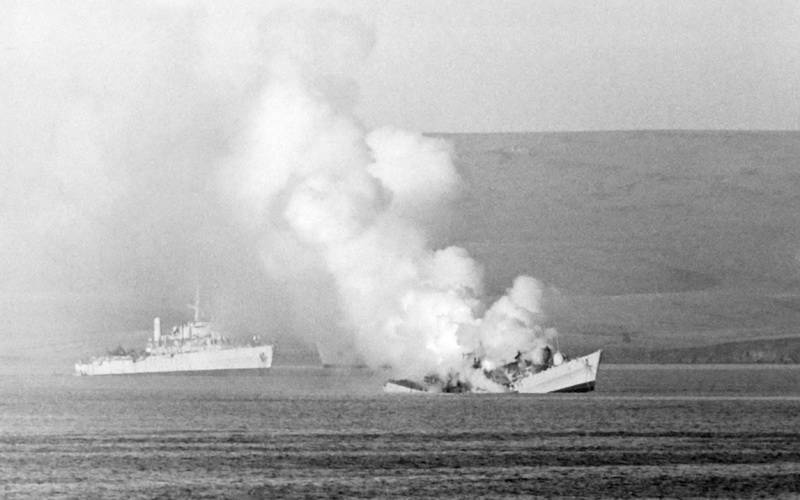
Neither 22, nor 23 in May, the Argentines could not create pressure on the British, similar to the fact that they exerted 21 in May, but the British had no special reason for joy. When attempting to fire an unidentified aerial target, the Sea Dart failed on Coventry. The “Sea Wolf” air defense missile system at Broadsworth, on which so many hopes were pinned, demonstrated an amazing programming error - he perceived only those planes that flew directly to the air defense frigate as a threat. If the Daggers or Skyhawks attacked a nearby ship, flying past the Broadsworth, then Sea Wolfe categorically refused to see the target as a threat, and its fire control system would take the Argentines to escort. However, this problem was quickly resolved.
In general, the pendulum swung appreciably towards Britain - despite the losses suffered by warships, the British transports continued to unload without any interference. As a result of suitable reinforcements, the number of escort ships even increased. The Marine Corps deployed its Rapier air defense missile system, but more importantly, the British equipped anti-aircraft observation posts on Mount Sussex, which should help detect enemy planes in a timely manner.
The Argentines were aware that three days had passed, but they did not succeed in attacking the warships of the escort and could not inflict losses unacceptable for the British. And because of May 24 they switched to British transports.
However, the 24 in May, fighting in the air began the British, attacking the airfield of Port Stanley. " In 09.35, C-Harriers, dropping shrapnel bombs to anti-aircraft artillery positions, managed to disorganize Argentines' air defense for some time, and then the four “Harrier GR.3” threw a dozen time bombs on runways and buildings. This blow (according to the same scheme) was repeated twice more, in 12.50 and 14.55 - as a result, the airfield was out of action for six hours, and two light attack aircraft were destroyed on the ground.
But the Argentine Air Forces were preparing to give a crushing answer. The first blow should have been inflicted by 11 Skyhawks, operating in two groups of 6 and 5 planes, respectively. Six cars, traditionally “having lost” one (technical reasons!) Along the road, five of us went to the British from the southeast. Observers from Mount Sussex spotted them, anti-aircraft fire fell on them, but Sea Harriers failed to bring in and the "magnificent five" hit the transport landing ships Sir Lancelot, Sir Galahed and Sir Bidiver. Of course, all three bombs did not explode, but still a fire broke out at Lancelot. No Skyhawk was shot down, everyone returned to the airfield.
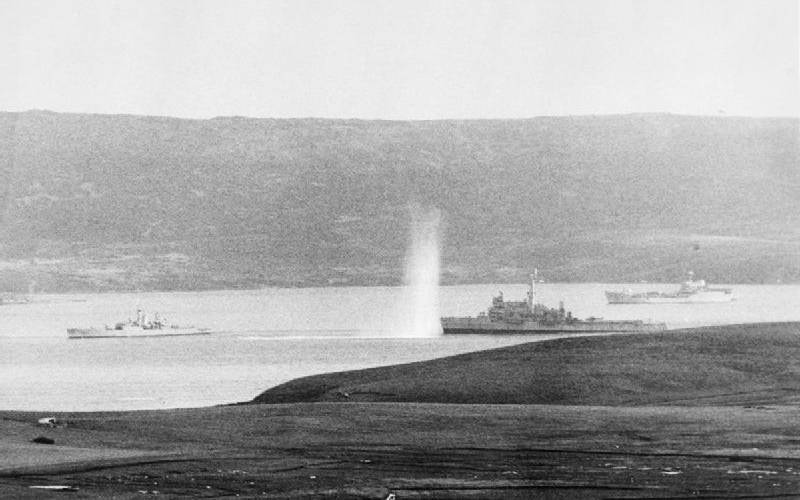
Approaching the second five "Skyhawks", which were supposed to strike from the north, found the duty destroyer "Coventry", immediately gave a target designation to the air patrol. The Skyhawks were intercepted and were forced to retire - the British this time were not able to shoot down a single aircraft, however the attack was completely disrupted. The second wave was to consist of 10 "Daggers", operating in two groups. The first, the four Daggers, attacked from the southeast, bombed Sir Bidiver, but could not hit it. Not one Dagger was shot down, but still two of them were badly damaged by anti-aircraft fire. Already on departure, the Argentines tried to catch up with the English fighter, but, of course, unsuccessfully - using their superiority in speed, the Daggers easily broke away from him. The second detachment consisted of two links of three cars. The first link broke through to the British ships, attacked Fort Austin, Stromness and Norland, and then another fuel depot on the shore. They were fired at by SAMs and artillery from ships, the Bloupips and the Rapiers of the Marine Corps, all three aircraft were damaged, but they were all still able to return home.
The second link was discovered by the Coventry and completely destroyed by the Sea Harrier air patrol that it had directed.
“The last chord” on that day was the raid of three Skyhocks, which bombed the Arrow frigate, which (according to the British data) did not receive any damage, which cannot be said of the planes attacking it. All three cars managed to lie on the opposite course, but one of the Skyhawks crashed into the sea - the pilot was killed. The other two cars were waiting for the same fate, each of them was dragged by a plume of fuel from punched tanks, but ... the Argentines made a non-standard move and sent the C-130 “flying tanker” “Hercules” to the rescue. He docked with both cars, and so, continuously supplying fuel to the mutilated Skyhawks, the three of them were able to reach the airfield.
So ended that day. Argentine aviation made the entire 24 aircraft, of the six attacking groups of aircraft, the British VTOL aircraft managed to intercept only two, but in both cases the attacks were completely disrupted. This, first of all, was a merit of the 42 / 22 patrol - Coventry and Broadsward, located in a good place, which allowed the British to learn about the groups of planes attacking from the north and direct their air patrols on them. The British did not lose a single ship, but three amphibious vehicles were damaged, but the Argentines lost three Daggers, Skyhawks, and also 2 Daggers and 2 Skyhawks were severely damaged and could hardly participate in the further battle.
Rear Admiral Woodworth saw that, the Argentines could not keep up the pace they had taken on 21 May. He also believed that 21-24 was able to destroy at least 24 airplanes and, moreover, a certain amount of damage was severely damaged. Therefore, he believed that he won in this war of attrition and that he destroys the forces of the enemy faster than they destroy his ships. In addition, the British were regularly approached by new destroyers and frigates and were still expected (in those days, the destroyers Bristol and Cardiff joined the 317 operational unit, as well as four frigates, but the author of the above ships did not get to 25 in May he knows that the frigate Avenger has most certainly arrived, but the Argentines had nowhere to wait for reinforcements. And the commander of the 317 connection looked into the future with optimism.
But he also saw that, despite the smaller number of sorties and attacks, the Argentines were again fighting extremely bravely (22 and especially 23 in May their determination to fight seemed to be greatly shaken). In addition, the British commander knew that the next day, 25 May, is celebrated by Argentina as the greatest national holiday, Independence Day. Therefore, one should expect a climax: the Argentines are likely to throw into the battle everything they can and, perhaps, their fleet will do the same.
To be continued ...
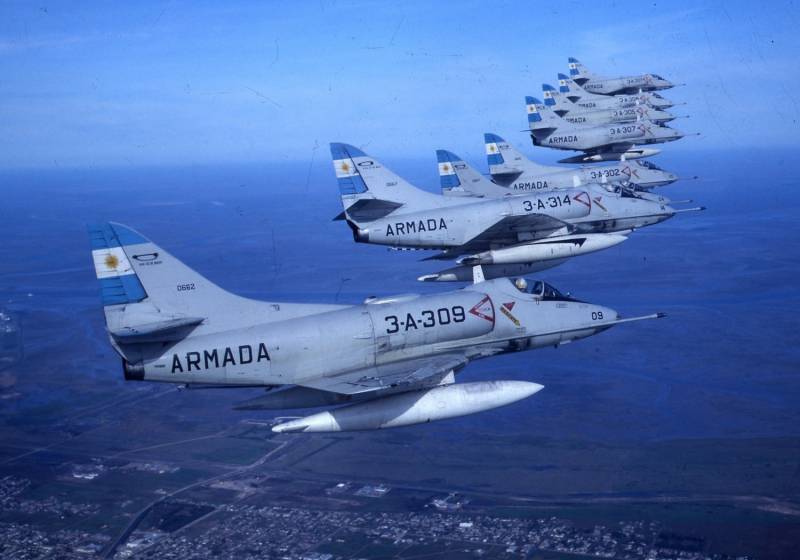
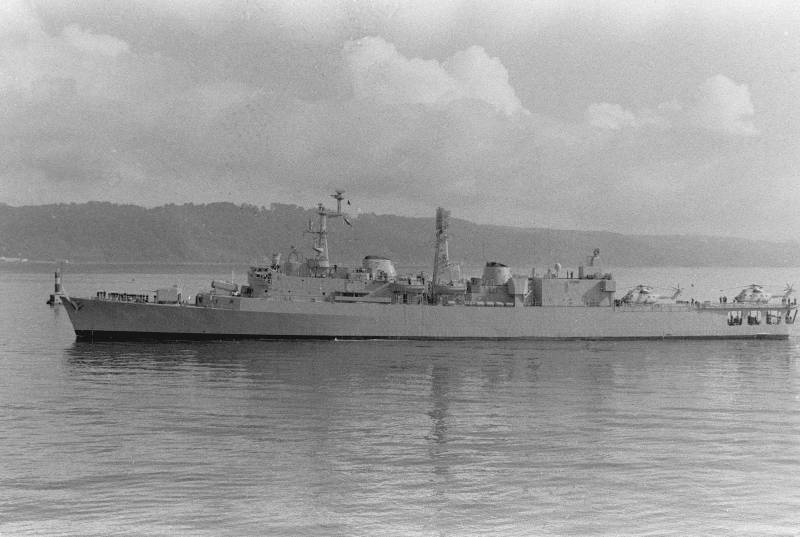
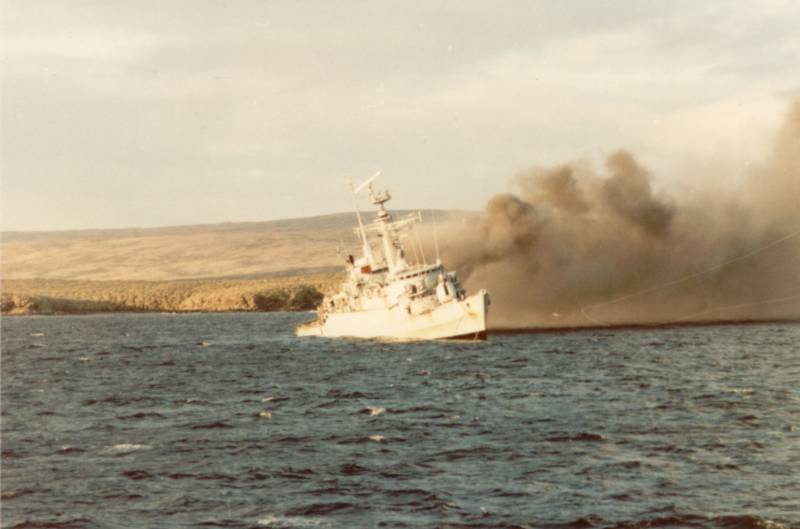
Information